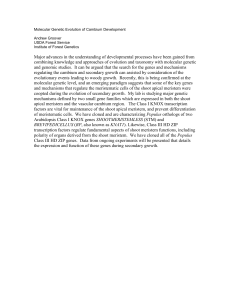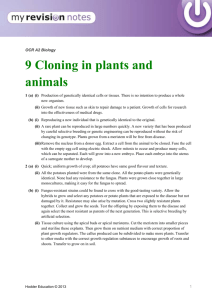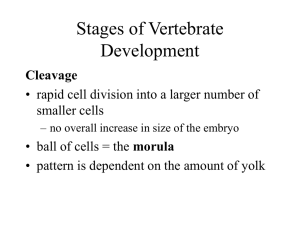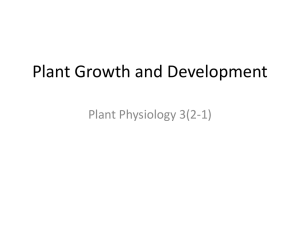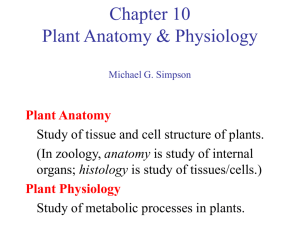This is only a guide to study. This is not... reading assignments. The exam is Tuesday monring, 8 am. 50...
advertisement
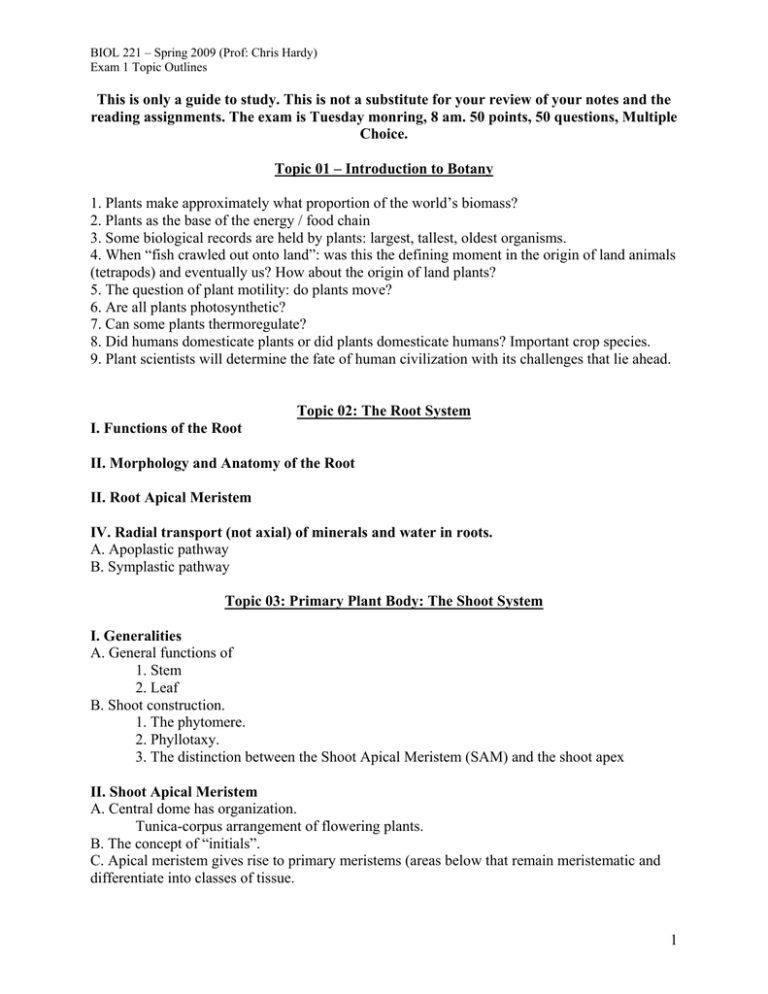
BIOL 221 – Spring 2009 (Prof: Chris Hardy) Exam 1 Topic Outlines This is only a guide to study. This is not a substitute for your review of your notes and the reading assignments. The exam is Tuesday monring, 8 am. 50 points, 50 questions, Multiple Choice. Topic 01 – Introduction to Botany 1. Plants make approximately what proportion of the world’s biomass? 2. Plants as the base of the energy / food chain 3. Some biological records are held by plants: largest, tallest, oldest organisms. 4. When “fish crawled out onto land”: was this the defining moment in the origin of land animals (tetrapods) and eventually us? How about the origin of land plants? 5. The question of plant motility: do plants move? 6. Are all plants photosynthetic? 7. Can some plants thermoregulate? 8. Did humans domesticate plants or did plants domesticate humans? Important crop species. 9. Plant scientists will determine the fate of human civilization with its challenges that lie ahead. Topic 02: The Root System I. Functions of the Root II. Morphology and Anatomy of the Root II. Root Apical Meristem IV. Radial transport (not axial) of minerals and water in roots. A. Apoplastic pathway B. Symplastic pathway Topic 03: Primary Plant Body: The Shoot System I. Generalities A. General functions of 1. Stem 2. Leaf B. Shoot construction. 1. The phytomere. 2. Phyllotaxy. 3. The distinction between the Shoot Apical Meristem (SAM) and the shoot apex II. Shoot Apical Meristem A. Central dome has organization. Tunica-corpus arrangement of flowering plants. B. The concept of “initials”. C. Apical meristem gives rise to primary meristems (areas below that remain meristematic and differentiate into classes of tissue. 1 BIOL 221 – Spring 2009 (Prof: Chris Hardy) Exam 1 Topic Outlines 1. protoderm 2. procambium 3. ground meristem D. Leaf primordia form on periphery. Later, axillary bud primordia form in the axils of these leaves. E. Apical dominance and the role of auxin III. Stem morphology and anatomy A. Morphology B. Anatomy IV. Leaf morphology and anatomy A. Morphology 1. Parts of the leaf Blade Margin (entire vs. toothed or lobed) Petiole (petiolate vs. sessile) Stipules (stipulate vs. exstipulate) Sheathing or not. 2. Complexity terms Simple, compound (leaflets) Palmate vs. Pinnately compound Leaf defined by attachment to stem and presence of axillary bud. Reticulate (netted) vs. parallel venation Pinnate vs. Palmate reticulate venation. 3. Trichomes can be present. B. Anatomy 1. DTS, VTS, GTS 2. DTS and distribution of stomata 3. VTS and distribution of xylem and phloem 4. GTS and mesophyll parencyma palisade vs. spongy Topic 04 The Embryo, Seed, and Seedling I. Seed A. Seed Structure 1. Embryo 2. Endosperm (angiosperms) 3. Seed coat 4. Structures visible on the seed: hilum, micropyle (e.g., kidney bean). 2 BIOL 221 – Spring 2009 (Prof: Chris Hardy) Exam 1 Topic Outlines 5. Ovule structure 6. Ethnobotany of Seeds e.g., corn – popcorn e.g., Wheat flour -White flour is what? -Bran is what? -Wheat germ is what? B. Where do seeds come from 1. Angiosperms 2. Gymnosperms C. Embryo structure 1.Cotyledons 2.Embryo axis a)Epicotyl (stem axis above cotyledon attachment) b)Hypocotyl (stem axis below cotyledon attachment) c)Radicle (embryonic root) d) RAM & SAM 3.Plumule (embryonic shoot with immature leaves) 4.Additional special structures or terms (e.g., corn seeds) a) coleoptile b) coleorhiza c) scutellum D. Germination 1. Breaking of dormancy 2. Types of germination a. Hypogeous = cotyledons remain underground b. Epigeous = cotyledons are lifted above the ground. E. Post-germination phenomena II. Embryogenesis A. Basal cell, suspensor, embryo-proper B. Some stages of embryogenesis 1. 2-celled stage 2. globular stage 3. heart 4. torpedo 5. bending cotyledons 6. mature embryo. Topic 05 Secondary Plant Body / Secondary Growth I.Secondary Growth A. Vascular cambium 3 BIOL 221 – Spring 2009 (Prof: Chris Hardy) Exam 1 Topic Outlines 1. Formation of 2. Bifacial nature of 3. Secondary xylem and secondary phloem 4. Initials -fusiform vs. ray -Divide largely periclinally (but occasionally anticlinally). 5. Growth Rings -Early wood vs. late wood 6. Secondary growth in roots Procambium and pericycle. B. Cork Cambium (phellogen) C. Lenticels II. Woody plant morphology A. Functions of wood. B. Transverse section of woody stem. 1. Wood Early (spring) wood vs. late (summer) wood Heart wood vs. sap wood Hardwoods vs. Softwoods 2. Bark Inner bark vs. Outer bark Topic 06 – Arborescent Monocots, “secondary growth” in monocots. Reading (optional): Stevenson, DW. 1980. Radial growth in Beaucarnea recurvata. American Journal of Botany 67(4): 476-489. Introduction: Phylogeny of seed plants shows that true-woodiness and eustele is plesiomorphic in seed plants. I. Arborescent Monocots. A. Banana “trees”. -Primary Thickening Meristem (PTM) -Psuedostem B. Palm trees (e.g., coconut palms) -PTM. -Diffuse growth below. -Fiber sheath of vascular bundles. 4 BIOL 221 – Spring 2009 (Prof: Chris Hardy) Exam 1 Topic Outlines C. Pony-tail Palm (Beaucarnea) & some palms & Joshua Trees. -PTM -STM 5


